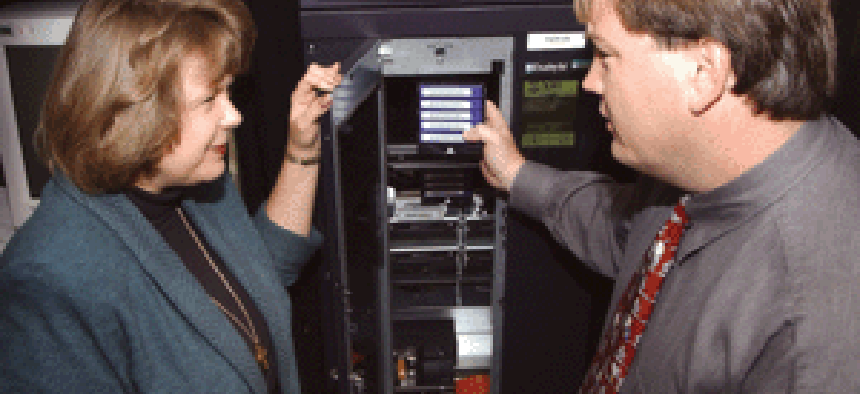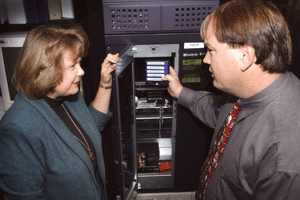SAN makes storage simple

The Air Force 45th Space Communications Squadron cut the time it spends backing up data from 12 hours to just two and one-half hours by installing a storage area network.
The Air Force 45th Space Communications Squadron cut the time it spends backing up data from 12 hours to just two and one-half hours by installing a storage area network. The 45th Space Wing provides its services to the John F. Kennedy Space Center in Cape Canaveral, Fla., to support about 30 Air Force rocket launches a year, said Sheryl Glore, the squadron's chief of implementations and standards. Its computer systems collect reams of data, such as telemetry and weather, related to the launches.Last September, the squadron installed a 3.5 terabyte SAN, divided between Cape Canaveral Air Force Station and Patrick Air Force Base, where the squadron is headquartered, said Glenn Exline, advanced technology manager for a squadron contractor. The base is a few miles south of the launch pads; the Space Wing has operations at both sites.The SAN uses a CLARiiON storage system from EMC Corp. of Hopkinton, Mass. It connects via Fibre Channel to the backup systems, two X80 MammothTape libraries from Exabyte Corp. of Boulder, Colo.Each tape has 60 gigabyte native capacity and can hold up to 150 gigabytes of compressed data, Exline said. Each library has four Exabyte Mammoth 2 drives, expandable to eight drives. There is a dedicated Fibre Channel attachment per drive, so expanding to eight drives wouldn't compromise bandwidth.To manage both the network and the back-end Fibre Channel SAN, the squadron administrators needed something that would work on one console. They already had Islandia, N.Y.-based Computer Associates International Inc.'s Unicenter network management platform for the IP network, so they chose the company's BrightStor SAN Manager."It gives us a nice overall picture of the health of our enterprise from one end to the other," Exline said.Before the storage area network, the IT staff had to limit data storage for about 3,500 users, Exline said. Daily backup requirements were nosing against the limits of a 12-hour time slot from 6 p.m. to 6 a.m. And even if plenty of storage had been available, the squadron couldn't have backed it up.To get more storage, the IT staff would normally "throw another server on the network, which has complexities associated with maintaining service packs and security," Exline said. "We saw that the more storage we added, the longer it took to back everything up. So if we didn't have a good backup infrastructure as part of the SAN, we could easily find ourselves in the same boat again -- having more storage than we could possibly back up," he said.With CA's BrightStor Enterprise Backup's serverless backup option, Exline said, he routinely sees data transfers at 800 megabytes to 1 gigabyte per minute per tape drive. Backup over the IP network had moved from 40 megabytes to 100 megabyte per minute per tape drive.Backups can now take place even at midday, because the data goes over the SAN and not the IP network. "I can back up the servers as quickly during the day as at night, and the users don't see an impact," Exline said.One day, the IT staff backed up the Space Wing's largest Microsoft Exchange Server platform in 10 minutes, starting at 8:30 a.m., "prime time for users logging in and checking e-mail," he said.The IT staff found a few weaknesses in the beta version they installed before BrightStor SAN Manager officially launched in January. There was a hiccup in loading the proxy agent that was fixed in the final release."SANs and IP networks are kind of hard for folks to get their heads around," Exline said. The software presented a graphical view of the separate Fibre Channel and IP networks for explanations to senior officials."Glenn and his group did some serious homework before we ever purchased this," Glore said. The SAN installation went well, she said, and the network arrangement is "a big step toward giving users the storage space they need."Exline said: "Our user base reaches from admin folks to people who really are rocket scientists." * Patricia Daukantas is a staff writer for Government Computer News and can be reached at pdaukantas@postnewsweektech.com.


Sheryl Glore, standards chief for the Air Force's 45th Space Communications Squadron, checks out an Exabyte X80 tape library with contractor Glenn Exline. The tape library helps the squadron duplicate crucial launch data.
NEXT STORY: Buy Lines: Since when is competition bad?